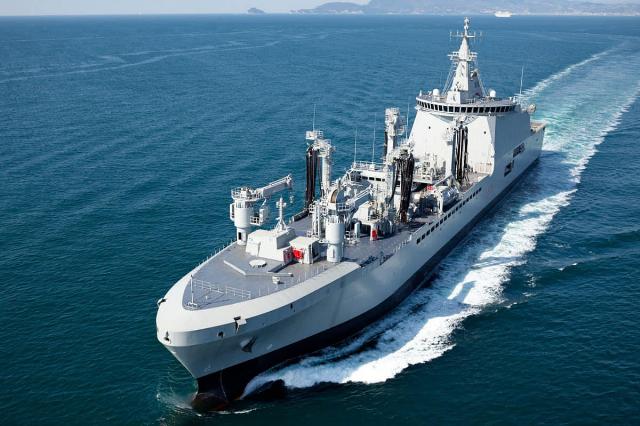In recent years, there has been renewed interest in the purchase of auxiliary vessels, which was largely neglected in the post-Cold War era. The reasons for the growth of this market are diverse and diverse: the expiration of the service life of existing vessels, the need to comply with stricter environmental standards, as well as the revision of operational concepts that place higher demands on logistics at sea.
Auxiliary vessels that are currently being built and supplied are usually of the next generation after those that are part of existing fleets of MTO vessels, and often feature significant technological improvements. This article discusses some of the main programs currently being implemented.
Auxiliary vessels for the US Navy
The United States is currently implementing the world's largest MTO vessel acquisition program. They need 20 new tanker trucks, mostly to replace the aging Henry J. Kaiser" (T-AO-187). Unlike many other navies, the US Navy mainly operates separate types of MTO ships, focused either on replenishing liquid (fuel and drinking water) or solid (food, ammunition and universal warehouses) stocks, although capable of providing a number of consumables of both types. This approach is probably dictated by the high demands of supporting the fleet's aircraft carrier strike groups.
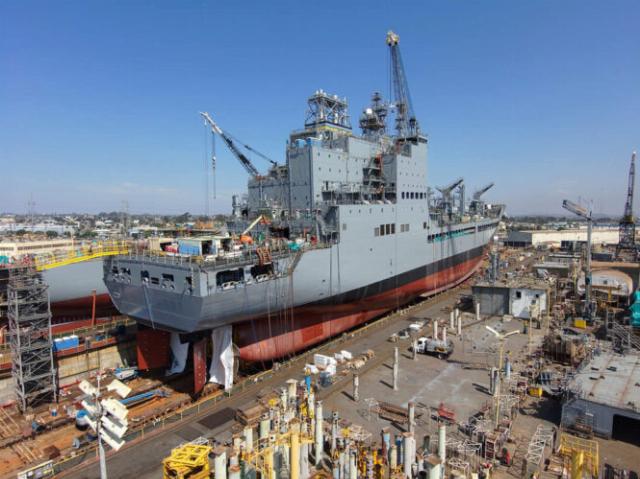
The third tanker tanker of the John Lewis type, Earl Warren (T-AO-207), pictured during construction by General Dynamics NASSCO. The photo shows that modern tanker trucks are increasingly using double frames with two shafts and double rudders.
The current tanker construction program was initiated more than a decade ago as part of the Future Fleet Replenishment Ship / T-AO-X project. After completion of the design work and competitive selection of suppliers, General Dynamics NASSCO received a contract in June 2016 for the design and production of the first six auxiliary vessels of the John Lewis project (John Lewis / T-AO-205).
The contract included a firm commitment to the construction of the lead vessel and options for the construction of the remaining five vessels, which were subsequently implemented. Three more ships were ordered at the shipyard in 2022 and 2023. Another mass purchase, announced in September 2024, includes eight more units, bringing production to a total of 17 of the 20 planned vessels, if congressional approval is received. By the end of 2024, the first three vessels of the project have been delivered to the customer.
When fully loaded, John Lewis tankers with a displacement of almost 50 thousand tons are capable of transporting 162 thousand barrels of fuel and 200 tons of drinking water. There is additional space for dry and refrigerated storage.
A total of five filling stations – three on the port side and two on the starboard side – are complemented by an aft filling station, two stations for the transfer of bulk cargo and two cargo cranes. The presence of a helipad allows for vertical resupply (VERTREP). Most defensive equipment is provided on a "provided but not included" basis.
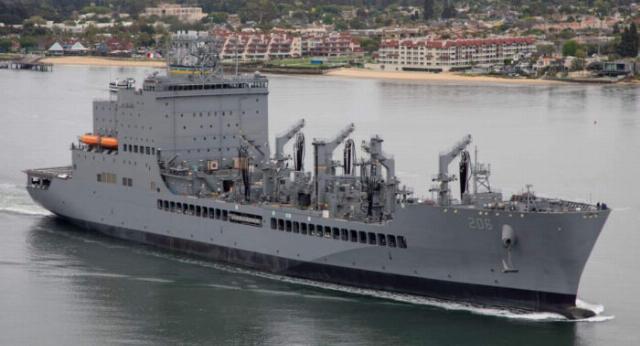
John Lewis type Harvey Milk tanker
Vessels of the John Lewis type are intentionally designed to reduce the risks of the project by rejecting new technologies. Despite this, the vessels reflect modern design methods, which include the use of a double hull in accordance with environmental standards for commercial tankers.
The shape of their hull also includes a double cheekbone, two wall rails and double rudders, which enhance maneuverability and reliability during potentially dangerous resupply operations. The main power plant uses two main Fairbanks Morse MAN 12V 48/60 CR diesel engines with a capacity of 14.4 MW, connected to the shafts by a downshift. The possibility of power take-off/supply (PTO/PTI) provides additional flexibility in operation.
Earl Warren tanker of the John Lewis type
As is the case with many other U.S. Navy projects, implementing a tanker tanker program is expensive. The lead vessel, launched in 2022, cost $716 million, which is $76 million more than originally planned. It is reported that the cost of the last batch of eight ships is 6.75 billion US dollars (just over 840 million US dollars per unit).
Moreover, the concept of distributed maritime operations (DMO) The US Navy is increasing its logistical requirements. Thus, a new T-AOL tanker is currently being developed, which will be cheaper than the T-AO-205. It is expected that the first of them will be launched in fiscal year 2027 at a cost of about $450 million, which is more than three times the initial estimate. A program is currently being planned that includes 13 such auxiliary vessels.
France and Italy
If we talk about Europe, then the most ambitious program for the construction of omnipotent vessels on the continent involves the acquisition by France and Italy of four vessels of a common design from the Italian Fincantieri.
Their construction began with an order for an MTO vessel of the ITS Vulcano project for the Italian Navy. This is one of several vessels whose construction is authorized as part of the fleet renewal program in accordance with the so-called "Fleet Law" of 2014. The vessel, commissioned in March 2021 after delays caused by a fire on board and the subsequent COVID-19 pandemic, will be followed by a second vessel, the Atlante, ordered in December 2021. Two additional ships are still in the planning stages.
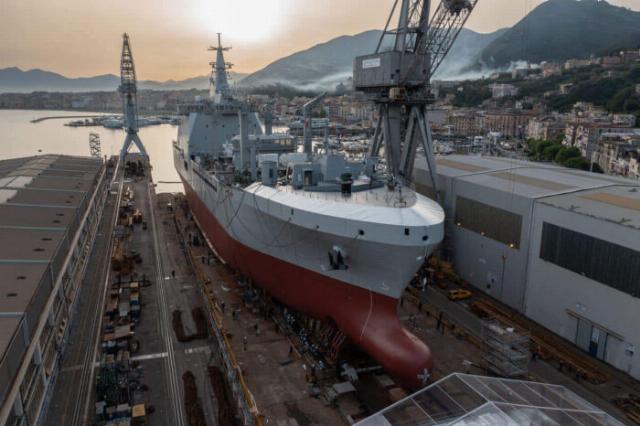
The second MTO vessel, ITS Atlante, of the Vulcano type of the Italian Navy, before launching on May 18, 2024.
The lead ship was assembled at the Fincantieri shipyard in Mugiano near La Spezia from sections made in nearby Riva Trigoso and Castellammare di Stabia near Naples. The last mentioned company will assume sole responsibility for other ships of the Italian Navy. Together, the Vulcano vessels will replace three auxiliary vessels of the Stromboli and Etna types. Interestingly, the cost of building the Vulcano lead ship was 375 million euros, while the Atlante order was already estimated at 410 million euros.
The choice of the Vulcano project to meet the requirements of the French Navy for the replacement of Durance tankers can be linked to Fincantieri's plans to acquire the Chantiers de l'Atlantique shipyard in Saint-Nazaire, where new auxiliary vessels were to be assembled. The decision to adapt the Italian design to the requirements of France replaced previous proposals based on the concept of the MTO ship of the naval group known as BRAVE.
In January 2019, an order was placed for four vessels, officially designated as "supply ships" (bâtiments ravitailleurs de forces / BRF), with a reported value of 1.7 billion. euro. Despite the fact that the Naval Group project was not selected for construction, the company is part of the winning consortium and plays an important role in system integration.
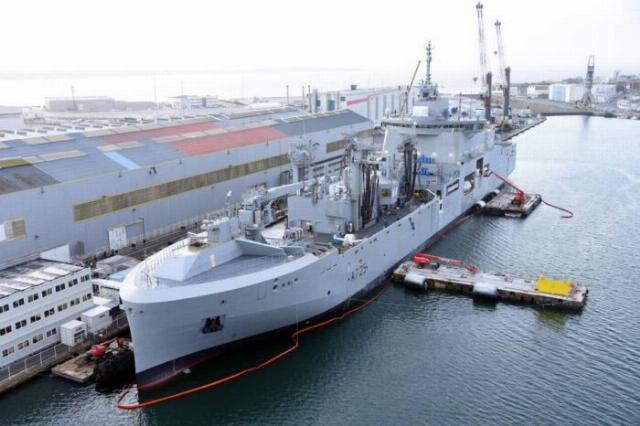
Auxiliary vessel FS "Jacques Chevalier" of the French Navy type "Vulcano"
All four are planned to be assembled at the Chantiers de l'Atlantique shipyard from sections manufactured at this shipyard and in Castellammare di Stabia. The lead vessel FS Jacques Chevalier was officially handed over to the customer in July 2023 after an extensive series of tests. The second and third vessels are currently at different stages of construction.
In contrast to the practice of the US Navy, the Vulcano-class ships and their French counterparts are real multi-purpose MTO vessels, in which relatively more attention is paid to the transportation of ammunition and other dry cargo than in ships of the John Lewis type. They also provide extensive repair and maintenance facilities, as well as a fully equipped (in accordance with the NATO "dual-use" concept) hospital supporting humanitarian activities and crisis response.
When fully loaded with a displacement of about 27 thousand tons, the Italian variants in their double hulls can carry about 14,500 cubic meters of liquids. In addition, they can carry about 220 tons of ammunition, additional solid cargo and eight ISO 20 containers.
There are two offshore replenishment stations (RAS) for liquid and solid cargo on the port and starboard sides. Additional replenishment options are provided by a feed refueling station, two cranes and a VERTREP pad. The combined diesel-electric and diesel power plant (CODLAD), coupled to two shafts, is more flexible than traditional all-diesel solutions. It provides high autonomy and allows for a usable maximum speed of 20 knots.
French auxiliary vessels of the Jacques Chevalier type differ from their Italian counterparts, primarily by the modified shape of the bow. Their displacement is about 31 thousand tons, they are also wider than Italian ships and have a higher carrying capacity. Another important difference is the all-electric power plant, which uses electric motors manufactured by GE Vernova, powered by MAN diesel generators.
Like Italian ships, French ships have better defensive capabilities than their American counterparts, as well as broader command and control capabilities. This reflects the greater likelihood that they will operate outside the FEU's protective umbrella, as well as the fewer large ships available to perform command functions.
According to the materials of the resource euro-sd.com
